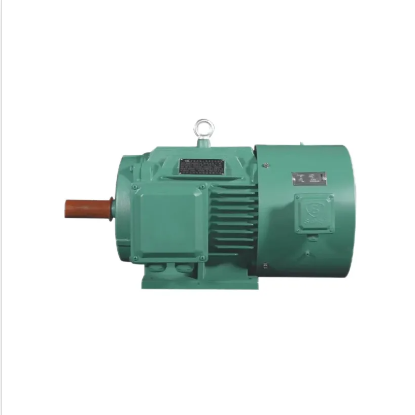The Technology Behind Variable Frequency Motors
Power Conversion: From AC to Variable Frequency
Variable Frequency Motors work by first converting regular AC power into something called variable frequency. Regular AC electricity keeps changing direction all the time, but we need to modify this to get different frequencies so we can control how fast the motor spins and what kind of force it produces. A bunch of things affect how well this conversion happens. On the hardware side there are inverters and transformers doing most of the heavy lifting, while on the software side complex algorithms run behind the scenes to keep everything precise. These parts need to work together pretty well if we want reliable results from our conversions. The control systems are really important too because they tweak those frequencies just right to make sure the motor runs at peak performance without wasting energy. Take variable frequency drives for example these special control systems let motors adjust their speed based on exactly what the machine needs at any given moment, cutting down on wasted power and prolonging motor life in industrial settings.
Pulse Width Modulation Techniques
Pulse Width Modulation or PWM plays a key role when it comes to regulating how fast motors run in Variable Frequency Motor systems. The basic idea behind PWM is simple enough really – it adjusts the width of electrical pulses sent to the motor, which controls just how much power actually gets delivered. There are several different approaches to implementing PWM though. Some common ones include sine wave PWM and what's called space vector modulation. Space vector stands out because it cuts down on those pesky harmonics while making power conversion more efficient overall. What makes PWM so valuable isn't just about saving energy either. When properly tuned, these modulation techniques cut back on wasted electricity and put less stress on motor components over time. For manufacturers looking to keep costs down and reduce their environmental footprint, getting PWM right can mean substantial improvements in both performance and longevity across all sorts of industrial applications.
Precision Control in Conveyor and Material Handling
VFD motors are changing how efficient material handling works across conveyor systems throughout various industries. These motors let operators adjust both speed and torque precisely, so materials move smoothly without unnecessary stops or starts. That matters a lot in places like warehouses and factories where things need to keep moving consistently. Take food processing facilities for instance. When plant managers can adjust belt speeds just right, they get better product flow through the line while cutting down on wasted ingredients. The results speak for themselves too many plants report faster production rates and fewer shutdowns when they switch to variable frequency drives. Companies that invest in this kind of control typically find their whole operation runs smoother, with materials getting from point A to B much more efficiently than before.
Optimizing Pump and Fan Operations
VFDs offer some pretty big benefits when it comes to running pumps and fans efficiently. The way they work is pretty straightforward actually they change the motor speed based on what the system needs at any given moment. This leads to real money savings on electricity bills, especially for buildings with heating and cooling systems. Some numbers floating around suggest businesses that switch to these variable frequency motors can cut their power usage by almost a third sometimes even more depending on how old their equipment was before. Take a look at office complexes or shopping malls for example many have already installed VFD technology across their ventilation systems. What happens? Operational costs drop significantly while maintaining comfort levels for occupants. And let's face it, saving cash on utilities isn't the only perk. Companies install VFDs because they want to appear greener too. Lower energy consumption means smaller carbon footprints, which looks good on reports and helps meet those increasingly strict environmental regulations most industries now have to follow.
Reducing Energy Consumption in Variable Loads
Variable Frequency Drives, or VFDs for short, have become pretty important for cutting down on energy waste throughout manufacturing sectors. These devices work by changing how fast motors run based on what's actually needed at any given moment instead of just running full blast all the time. Take a look at factories where old school motors still run nonstop even when there's not much work happening they eat up way more power compared to those newer Variable Frequency Motors. Companies that make the switch often see their electric bills drop quite a bit over time. Plus, these motors tend to wear out slower too since they're not constantly maxed out. For businesses trying to save money while being greener, investing in VFD technology makes sense both financially and environmentally speaking.
Calculating Return on Investment
When figuring out the return on investment for variable frequency motors, most businesses find themselves going through several steps. Looking at things like how much money they save on electricity bills, lower repair expenses over time, and better overall system performance helps paint a clearer picture. What really matters though is understanding those upfront costs for installing VFD systems versus what kind of savings can be expected down the road plus how long these motors typically last before needing replacement. Some manufacturing plants actually saw their ROI numbers jump after switching to VFD technology. One factory reported cutting energy consumption by nearly 30% within just six months, while another facility noticed maintenance calls dropped by half over two years because their equipment ran smoother and lasted longer than traditional setups.
Mitigating Harmonic Distortion
Variable Frequency Motors (VFMs) create harmonic distortion problems that really mess with their efficiency and how well they perform overall. What happens here is basically different electrical signals bouncing around at various frequencies and getting in each other's way, leading to motors running hotter than they should and just not working as efficiently as possible. Motor technicians know this all too well. To fix things up, installing some kind of filtering system or special gear becomes necessary work. Passive filters have been around forever for this purpose while newer active filters do a pretty good job too at knocking down those pesky harmonics. Companies need to follow local rules about this stuff because getting caught out of compliance means paying fines nobody wants to see on their balance sheet. Industry numbers show that harmonics alone can knock as much as 10% off motor efficiency, so most maintenance managers will tell you spending money now on proper filtration makes sense long term instead of dealing with replacement costs later down the road.
Thermal Management Solutions
Keeping things cool is really important for making sure Variable Frequency Motors last longer and work reliably over time. When motors get too hot because they lack good thermal control, they tend to break down sooner than expected and end up costing money in repairs. Motor manufacturers have developed various methods to keep temperatures under control. Some standard approaches include installing better cooling systems and adding thermal barriers where needed. Heat sinks and special materials that conduct heat well are commonly used to get rid of extra warmth building up inside the motor housing. Industry data suggests around half of all motor failures happen because of poor thermal management practices. Getting thermal management right doesn't just stop breakdowns it actually makes motors perform better overall while saving on energy costs in the long run.
Smart Manufacturing and IIoT Integration
VFMs are changing how smart manufacturing works today, mainly because they boost both efficiency and flexibility on factory floors. What makes these motors so important? Well, they give manufacturers exact control over motor speeds, which means production lines can adjust quickly when demand changes throughout the day. When we talk about connecting IIoT solutions with VFMs though, there are some real headaches. Getting that real time data flowing smoothly across different systems is tough enough, let alone making sure everything integrates without causing major disruptions during setup. Most plants solve this by installing better sensors that communicate reliably and setting up cloud platforms where all the equipment can talk to each other without hiccups. Looking ahead at what's coming next for motor tech, especially VFMs, the outlook looks pretty good for smart factories. The latest improvements help automate processes much better while cutting down on wasted energy. This translates directly to lower operating costs and gives companies a stronger position against competitors who haven't made similar investments yet.
Sustainable Practices Through Regenerative Systems
Regenerative braking systems work hand in hand with variable frequency drives (VFDs) and mark real progress in making motor driven automation greener. Basically, these systems grab the energy that would normally go wasted when something stops moving and put it back into the system instead. This means better energy efficiency overall and helps move things toward more sustainable operations. Companies notice tangible advantages from this technology. They save on power costs and their machines last longer since there's less stress on components over time. Look at what's happening across different sectors now automotive production lines and factory assembly processes are increasingly turning to regenerative tech to comply with tougher environmental regulations. By cutting down on carbon emissions while still getting great performance out of their equipment, businesses are showing what real green manufacturing looks like in practice today.
FAQ Section
What are Variable Frequency Motors?
Variable Frequency Motors are motors that operate with variable frequency drives to control motor speed and torque by adjusting the motor supply frequency.
Why is Pulse Width Modulation important for Variable Frequency Motors?
Pulse Width Modulation is crucial because it controls the amount of power delivered to the motor, optimizing performance and efficiency while extending motor life.
In which industries are Variable Frequency Motors commonly used?
Variable Frequency Motors are widely used in industries like manufacturing, logistics, HVAC, and automotive due to their energy efficiency and precision control capabilities.
What are the benefits of using Variable Frequency Drives?
Variable Frequency Drives offer benefits such as significant energy savings, reduced utility costs, and optimized motor performance by matching speed with load requirements.
How do regenerative systems contribute to sustainability?
Regenerative systems contribute to sustainability by capturing and reusing energy that would otherwise be lost during processes like braking, thus reducing overall energy consumption.
Table of Contents
-
The Technology Behind Variable Frequency Motors
- Power Conversion: From AC to Variable Frequency
- Pulse Width Modulation Techniques
- Precision Control in Conveyor and Material Handling
- Optimizing Pump and Fan Operations
- Reducing Energy Consumption in Variable Loads
- Calculating Return on Investment
- Mitigating Harmonic Distortion
- Thermal Management Solutions
- Smart Manufacturing and IIoT Integration
- Sustainable Practices Through Regenerative Systems
- FAQ Section


